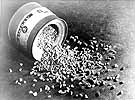
|
|
|

|

|

|

|
|
Click on an image to see a larger, more detailed picture.
|
|
|
|
|
| 1943: Death and Resistance |

|
pg. 490 |

|
|
|
|
| |
 Stanislaw Szmajzner, 16, participated in and helped to organize the revolt at the Sobibór death camp in October 1943. After the uprising, Szmajzner was one of the prisoners who successfully escaped and joined forces with Russian partisans. He was one of three members of his particular group to survive the war.
Stanislaw Szmajzner, 16, participated in and helped to organize the revolt at the Sobibór death camp in October 1943. After the uprising, Szmajzner was one of the prisoners who successfully escaped and joined forces with Russian partisans. He was one of three members of his particular group to survive the war.
Photo: Museum of Jewish Heritage/Center for Holocaust Studies / United States Holocaust Memorial Museum Photo Archive
|
 Ernst von Weizsäcker was a career diplomat who loyally served the Nazi regime. His career followed the path of his mentor, Foreign Minister Joachim von Ribbentrop. Weizsäcker served as chief state secretary from the time that Ribbentrop was appointed foreign minister until 1943, when he was named as the ambassador to the Vatican.
Ernst von Weizsäcker was a career diplomat who loyally served the Nazi regime. His career followed the path of his mentor, Foreign Minister Joachim von Ribbentrop. Weizsäcker served as chief state secretary from the time that Ribbentrop was appointed foreign minister until 1943, when he was named as the ambassador to the Vatican.
Photo: SYddeutscher Verlag Bilderdienst
|
 Zyklon B
Zyklon B
At six-week intervals in 1943, a truck dispatched from Auschwitz traveled to Dessau, Germany. It returned with hermetically sealed tin canisters of Zyklon B, the commercial name for the bluish hydrogen cyanide pellets that asphyxiated more than a million Jews in the Auschwitz killing center. A powerful pesticide developed during World War I, Zyklon B was used to combat contagious disease by fumigating lice-infested buildings. At first it served those purposes at Auschwitz, where overcrowding, malnutrition, and poor sanitation made dysentery, typhoid fever, and especially typhus constant threats. By late summer 1941, however, the Nazis experimented with Zyklon B on Soviet POWs. They found that the compound's vaporizing pellets offered a particularly reliable and efficient way to advance the "Final Solution." Two German companies--DEGESCH, a subsidiary of I.G. Farben, and Tesch and Stabenow Company--profited immensely by supplying Zyklon B to the SS. They even modified it for Auschwitz by removing the special odor that ordinarily warned people about their product's deadly presence. In 1942 Auschwitz used 8.2 tons of Zyklon B. The tonnage for 1943 was 13.4. Most of it was poured through small rooftop openings into gas chambers packed with Jews. Once exposed to air, the pellets produced lethal gas. Minutes later, after panic-filled screams, the human victims were dead.
Photo: Yad Vashem / United States Holocaust Memorial Museum Photo Archive
|
|

|

|

|

|
 October 16, 1943: German Ambassador to the Vatican Ernst von Weizsäcker compliments the Holy See for its "perfect even-handedness" in treating Germany and the Allies. When Weizsäcker asks what Pope Pius XII will do if the German government persists in its present Jewish policy in Italy, Vatican Secretary of State Maglione replies that "the Holy See would not want to be put in the position of having to utter a word of disapproval." The Pope is being "cautious so as not to give the German people the impression that [he] has done or has wished to do even the smallest thing against Germany during this terrible war."
October 16, 1943: German Ambassador to the Vatican Ernst von Weizsäcker compliments the Holy See for its "perfect even-handedness" in treating Germany and the Allies. When Weizsäcker asks what Pope Pius XII will do if the German government persists in its present Jewish policy in Italy, Vatican Secretary of State Maglione replies that "the Holy See would not want to be put in the position of having to utter a word of disapproval." The Pope is being "cautious so as not to give the German people the impression that [he] has done or has wished to do even the smallest thing against Germany during this terrible war."
|
 October 17, 1943: A Jewish partisan unit commanded by Abba Kovner destroys two rail engines and two bridges near Vilna, Lithuania.
October 17, 1943: A Jewish partisan unit commanded by Abba Kovner destroys two rail engines and two bridges near Vilna, Lithuania.
|
|
|
|
|
| 1943: Death and Resistance |

|
pg. 490 |

|
|
The Holocaust Chronicle
© 2009 Publications International, Ltd.
|
|
